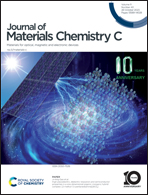Conductive hydrogels with core–shell structures to realize super-stretchable, highly sensitive, anti-dehydrating, non-freezing and self-adhesive capabilities†
Abstract
Traditional conductive hydrogels are inevitably dehydrated by water evaporation when exposed to dry environments, which greatly retards their applications. Although great efforts have been devoted to reducing water evaporation, a combination of excellent stretchability, high sensitivity, non-freezing properties and self-adhesive capability has hardly been realized. Inspired by painting, an emulsion from poly butyl acrylate was prepared and coated onto the surface of a micellar cross-linked polyacrylamide (PAM) hydrogel to prepare a hydrophobic coated PAM gel (C-PAM). The presence of a hydrophobic layer endowed it with excellent anti-drying capability (84 ± 0.45% weight retention after 7 days under ambient conditions), while micelle-like aggregates imparted excellent extensibility (elongation at break = 5200%). The introduction of poly butyl acrylate also empowered self-adhesive properties. The C-PAM hydrogel could adhere to rubber, cardboard, metal, wood, glass and plastic with strengths of 38.59 ± 8.29, 47.42 ± 8.06, 15.53 ± 2.61, 46.54 ± 7.92, 14.71 ± 2.17 and 29.33 ± 3.11 kPa, respectively. The adoption of sodium chloride (NaCl) imparted high sensitivity (GF = 6.41) and anti-freezing properties (−20 °C). Bearing multi-functions, the reported strategy is expected to significantly broaden the applications of conductive hydrogels.



 Please wait while we load your content...
Please wait while we load your content...